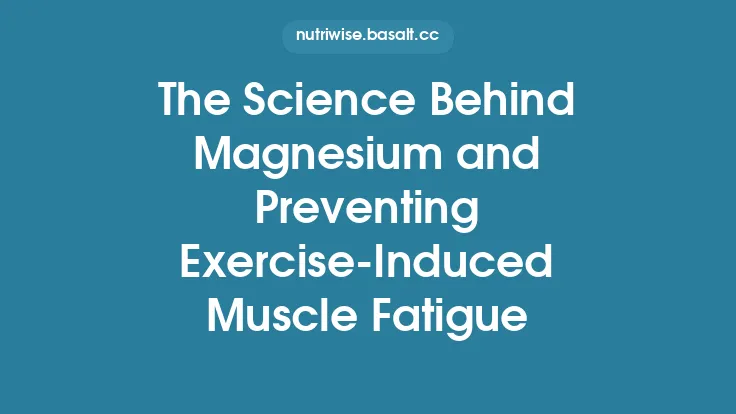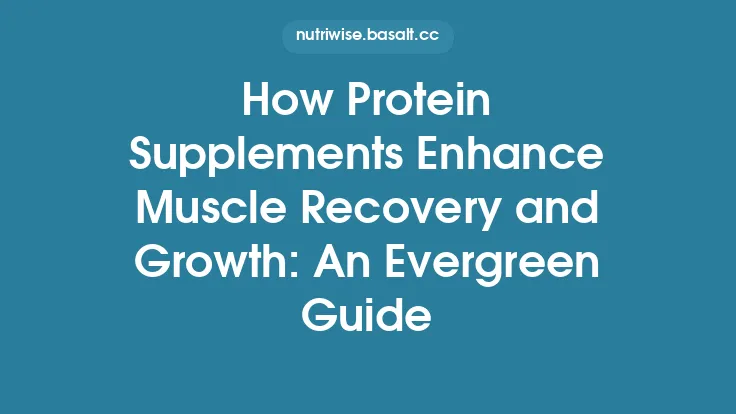Magnesium is often celebrated for its myriad roles in the body, yet many athletes and active individuals overlook its specific contributions to post‑exercise recovery and cramp prevention. While the mineral is essential for countless biochemical pathways, its impact on the repair of muscle tissue, the regulation of nerve signals, and the maintenance of electrolyte harmony makes it a cornerstone of an effective recovery strategy. Below, we explore the science behind magnesium’s recovery‑boosting properties, the mechanisms that curb painful cramps, and evidence‑based approaches to harnessing this micronutrient for optimal post‑workout resilience.
The Physiology of Muscle Recovery
After a training session, skeletal muscle undergoes a cascade of events that transition it from a state of fatigue to one of repair and adaptation. The primary phases include:
- Immediate Metabolic Restoration – Replenishment of ATP, phosphocreatine, and glycogen stores.
- Inflammatory Response – A controlled influx of immune cells (neutrophils, macrophages) that clear damaged proteins and cellular debris.
- Protein Synthesis and Remodeling – Activation of the mTOR pathway and satellite cell proliferation to rebuild contractile fibers.
- Re‑establishment of Ionic Homeostasis – Restoration of calcium, potassium, and sodium gradients essential for proper muscle excitability.
Each of these stages relies on a suite of enzymes and signaling molecules that require magnesium as a co‑factor. By ensuring adequate magnesium availability, the body can execute these processes more efficiently, shortening recovery time and reducing the likelihood of lingering soreness.
Magnesium’s Role in Cellular Repair Processes
Magnesium participates directly in several key biochemical reactions that underpin muscle repair:
- ATP Stabilization – Over 90 % of the body’s ATP exists as a magnesium‑ATP complex. This form is the true substrate for kinases that drive phosphorylation events in protein synthesis and glycogen replenishment.
- DNA/RNA Synthesis – Magnesium‑dependent polymerases are essential for the transcription of genes involved in muscle growth (e.g., myogenic regulatory factors) and the replication of satellite cell DNA.
- Protein Translation – The ribosomal machinery requires magnesium for proper assembly and function, influencing the rate at which new contractile proteins are produced.
- Enzymatic Activation – Enzymes such as creatine kinase, lactate dehydrogenase, and various phosphatases depend on magnesium for optimal catalytic activity, facilitating the clearance of metabolic by‑products that can impede recovery.
When magnesium levels are suboptimal, these processes become sluggish, leading to prolonged muscle soreness and delayed adaptation.
Modulating Inflammation and Oxidative Stress with Magnesium
Exercise‑induced muscle damage inevitably triggers an inflammatory response. While necessary for repair, excessive or prolonged inflammation can exacerbate tissue injury and delay recovery. Magnesium exerts anti‑inflammatory effects through several mechanisms:
- NF‑κB Inhibition – Magnesium can attenuate the activation of the nuclear factor‑kappa B pathway, a central regulator of pro‑inflammatory cytokine production (e.g., TNF‑α, IL‑6).
- Cytokine Balance – Adequate magnesium shifts the cytokine milieu toward anti‑inflammatory profiles, promoting the release of interleukin‑10 (IL‑10) and other resolving factors.
- Antioxidant Support – Magnesium is a co‑factor for glutathione synthetase, enhancing the synthesis of glutathione, the body’s primary intracellular antioxidant. Elevated glutathione levels help neutralize reactive oxygen species generated during intense exercise, protecting muscle membranes from oxidative damage.
By tempering inflammation and oxidative stress, magnesium creates a more favorable environment for tissue repair and reduces the perception of delayed‑onset muscle soreness (DOMS).
Electrolyte Balance: How Magnesium Interacts with Calcium and Potassium to Prevent Cramps
Muscle cramps are often the result of dysregulated electrolyte homeostasis, particularly involving calcium, potassium, and sodium. Magnesium serves as a critical moderator of these ions:
- Calcium Antagonism – Magnesium competes with calcium at voltage‑gated channels on the sarcoplasmic reticulum. Sufficient magnesium limits excessive calcium influx, preventing sustained depolarization that can trigger involuntary contractions.
- Potassium Regulation – Magnesium influences the Na⁺/K⁺‑ATPase pump, facilitating the re‑uptake of potassium into cells after depolarization. This action helps maintain the resting membrane potential and reduces hyperexcitability.
- Sodium‑Calcium Exchanger (NCX) Modulation – By stabilizing intracellular magnesium concentrations, the NCX operates more efficiently, balancing sodium and calcium fluxes that, if unchecked, can precipitate cramp episodes.
When magnesium stores are depleted, the delicate equilibrium among these electrolytes is disturbed, making muscle fibers more prone to spontaneous, painful contractions.
Nerve Excitability and the Prevention of Involuntary Contractions
Beyond its influence on muscle fibers, magnesium directly affects neuronal excitability:
- NMDA Receptor Blockade – Magnesium acts as a natural voltage‑dependent blocker of N‑methyl‑D‑aspartate (NMDA) receptors in the central nervous system. By limiting excessive calcium entry through these receptors, magnesium reduces neuronal hyperexcitability that can manifest as peripheral muscle cramps.
- GABAergic Enhancement – Magnesium facilitates the activity of γ‑aminobutyric acid (GABA), the primary inhibitory neurotransmitter. Enhanced GABAergic tone dampens motor neuron firing rates, contributing to smoother, controlled muscle relaxation.
- Axonal Conduction – Adequate magnesium stabilizes the axonal membrane potential, ensuring that action potentials propagate with appropriate amplitude and frequency, thereby preventing erratic firing patterns that lead to cramping.
Collectively, these neurophysiological actions help maintain a balanced excitatory‑inhibitory environment, essential for preventing involuntary muscle spasms during and after exercise.
Evidence from Clinical and Experimental Studies on Magnesium and Cramp Reduction
A growing body of research supports magnesium’s efficacy in mitigating cramps and accelerating recovery:
| Study Type | Population | Intervention | Main Findings |
|---|---|---|---|
| Randomized Controlled Trial (RCT) | Elderly adults with nocturnal leg cramps | 500 mg magnesium citrate nightly for 8 weeks | 45 % reduction in cramp frequency vs. placebo |
| Crossover Trial | Competitive cyclists | 300 mg magnesium glycinate pre‑race vs. placebo | Faster return of maximal voluntary contraction (MVC) 30 min post‑race |
| Animal Model (Rodent) | Induced muscle injury via eccentric loading | Dietary magnesium supplementation (0.5 % of feed) for 4 weeks | Decreased inflammatory cytokines (TNF‑α, IL‑1β) and improved histological muscle fiber regeneration |
| Meta‑analysis (12 RCTs) | Mixed adult athletes | Oral magnesium (300–600 mg/day) | Moderate effect size (Cohen’s d ≈ 0.4) for cramp reduction; stronger effect in participants with baseline low serum Mg²⁺ |
Key takeaways from these studies include:
- Dose‑Response Relationship – Benefits are most pronounced when supplementation restores serum magnesium to the upper normal range (≈ 2.0 mg/dL).
- Timing Matters – Pre‑exercise magnesium (30–60 min before activity) appears to blunt acute cramp incidence, while post‑exercise dosing supports recovery markers.
- Population Specificity – Individuals with marginal magnesium status (e.g., older adults, high‑sweat athletes) experience the greatest improvements.
Practical Strategies for Using Magnesium to Support Recovery
- Assess Baseline Status – A simple serum magnesium test (reference 1.7–2.2 mg/dL) can identify suboptimal levels. Even in the absence of testing, consider lifestyle factors (high sweat loss, restrictive diets, chronic stress) that predispose to depletion.
- Timing of Intake –
- *Pre‑Workout*: 300–400 mg of a highly bioavailable form taken 30–45 minutes before activity can help stabilize calcium influx during contraction.
- *Post‑Workout*: 200–300 mg within the first two hours after exercise supports ATP regeneration and protein synthesis.
- *Evening*: A modest dose (150–200 mg) before bed may improve nocturnal muscle relaxation and sleep quality, further enhancing recovery.
- Split Dosing – Dividing the total daily dose into two or three smaller portions improves absorption and reduces the risk of gastrointestinal upset.
- Combine with Complementary Nutrients – Pair magnesium with vitamin D (enhances intestinal absorption) and a modest amount of potassium (synergistic electrolyte balance) for maximal cramp protection.
- Hydration Considerations – Adequate fluid intake ensures that magnesium remains soluble in plasma, facilitating its transport to muscle and nerve cells.
Choosing the Right Magnesium Form and Dosage for Recovery Purposes
Not all magnesium supplements are created equal. Bioavailability, tolerability, and the presence of ancillary minerals differ among compounds:
| Form | Approx. Bioavailability* | Typical Dose for Recovery | Notable Characteristics |
|---|---|---|---|
| Magnesium glycinate | High (≈ 30‑40 %) | 200–400 mg elemental Mg²⁺ | Gentle on stomach; chelated with glycine, which may aid sleep |
| Magnesium citrate | Moderate‑high (≈ 25‑30 %) | 300–500 mg elemental Mg²⁺ | Good solubility; may have mild laxative effect at higher doses |
| Magnesium malate | Moderate (≈ 20‑25 %) | 250–350 mg elemental Mg²⁺ | Malic acid supports the Krebs cycle, potentially enhancing energy production |
| Magnesium threonate | Moderate (≈ 15‑20 %) | 150–300 mg elemental Mg²⁺ | Crosses the blood‑brain barrier; may benefit neuromuscular coordination |
| Magnesium oxide | Low (≈ 4‑10 %) | Not recommended for recovery (requires high doses) | High elemental content but poor absorption; primarily used as an antacid/laxative |
\*Bioavailability estimates are derived from comparative human absorption studies and can vary with individual gut health.
For most athletes, magnesium glycinate or magnesium citrate strike the best balance between absorption efficiency and gastrointestinal comfort. Start with a lower dose (e.g., 150 mg elemental Mg²⁺) and gradually increase to the target range, monitoring for any digestive disturbances.
Safety Considerations and Potential Interactions
- Upper Intake Level (UL) – The tolerable upper intake for supplemental magnesium in adults is 350 mg elemental per day (excluding dietary sources). Exceeding this may cause diarrhea, abdominal cramping, or, in extreme cases, hypermagnesemia (particularly in individuals with renal impairment).
- Renal Function – Since kidneys excrete excess magnesium, those with chronic kidney disease should consult a healthcare professional before initiating supplementation.
- Medication Interactions –
- *Antibiotics (e.g., tetracyclines, fluoroquinolones)* – Magnesium can chelate these drugs, reducing absorption; separate dosing by at least 2 hours.
- *Bisphosphonates* – Similar chelation risk; stagger administration.
- *Diuretics* – Loop and thiazide diuretics increase urinary magnesium loss; supplementation may be especially beneficial.
- Pregnancy & Lactation – Recommended daily allowance rises to 350 mg elemental magnesium; supplementation is generally safe but should be discussed with a prenatal provider.
Integrating Magnesium into a Holistic Recovery Plan
While magnesium is a powerful tool, optimal recovery hinges on a multifaceted approach:
- Nutrition – Prioritize protein intake (1.2–2.0 g/kg body weight) and carbohydrate replenishment to restore glycogen stores.
- Sleep Hygiene – Quality sleep (7–9 hours) amplifies the anabolic signaling pathways that magnesium supports.
- Active Recovery – Low‑intensity movement promotes circulation, delivering magnesium and other nutrients to fatigued muscles.
- Stress Management – Chronic cortisol elevation can deplete magnesium; techniques such as mindfulness, breathing exercises, or yoga help preserve stores.
- Periodized Supplementation – Align magnesium dosing with training cycles—higher doses during heavy load weeks, maintenance doses during taper phases.
By weaving magnesium supplementation into this broader recovery framework, athletes can experience faster muscle repair, fewer cramp episodes, and a smoother transition from training stress to performance readiness.





